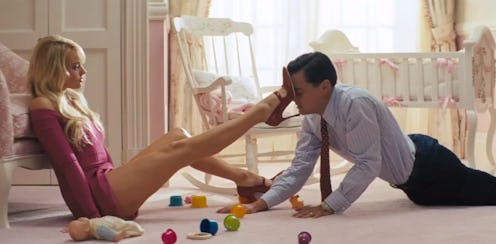Entertainment
Misogyny in this month's hottest film

The crowded theater tittered with laughter every time a naked or nipple-pasty-wearing hooker stumbled drunkenly around the screen or collapsed in a quaalude stupor. Men and women alike laughed unabashedly at the depiction of women as hookers, strippers, money-grubbing girlfriends, or helpless wives unable to curb their husbands' drug and sex addictions. The lack of strong female characters in The Wolf of Wall Street, a film heralded as one of the best of the season, raises interesting questions about how women are portrayed as accessories to their leading men.
In comparison to the women in American Hustle, the women of Wolf of Wall Street are sorely lacking in depth, strength, and feminism. Hooker and stripper discussions aside, (although Jordan Belfort, played by Leonardo DiCaprio, does go on a five minute rant about the varieties of hookers he has sex with) The female leads are not only tragic but also one-dimensional, used only to further the story.
We are introduced to the leading lady Naomi Lapaglia, played by Margot Robbie, halfway through the film as Belfort hosts a massive party to celebrate his excesses. Lapaglia is a sex symbol, taking over Belfort's mind and body as his first wife, Teresa Petrillo, portrayed by Cristin Milioti, is discarded for the blonde bombshell. He is utterly consumed with lust for Lapaglia, exemplified by the tantalizing scene (seen above) in which Lapaglia teases Belfort mercilessly for his sexual deviance. While the replacement does underscore Belfort’s transformation due to money and power, the women are used as foils rather than characters.
In a poignant scene in which Petrillo discovers Belfort snorting cocaine off Lapaglia's chest, Petrillo simply breaks down and cries, refusing to fight with Belfort for their marriage and instead disappearing, alongside Belfort's supposed three children, for the rest of the film. Even Lapaglia, Belfort's supposed foil and the love of his life, is portrayed as a sex-crazed gold-digger who immediately dumps Belfort after he is arrested and loses his money. We are meant to perceive the woman in a negative light, since she is abandoning Belfort in his time of need, despite the fact that Belfort continuously cheats on his wife and even abuses her and their children.
The misogynistic portrayals of women in Wolf of Wall Street could represent a time period in which women were relegated to certain spheres and were unable to lead lives outside of their husbands. It could also accurately portray the realities of the financial industry as a profession. The few women who are stockbrokers in the film are just as power-hungry as the men, yet we hear no mention of their philandering. Instead they are, as Belfort explains in a teary-eyed speech, single mothers rising from nothing to Armani suits. Certainly women of the 80s contained more thought and opinion then those developed on screen, despite their stereotypical roles. The amount of nudity and sex scenes force the women of Wolf of Wall Street into categories, stereotyping them instead of creating thoughtful and dynamic characters that are allowed to break out of their spheres to truly influence the tide of the film.
Yet perhaps the most disturbing aspect of this distinct lack of strong female characters is the fact that no one seems to have cared enough to stop laughing and start thinking. In the theater, people clapped and cheered for Belfort's debauchery, never pausing to really notice the women he used and abused along the way. This lack of strong female characters is unfortunately a theme in many of Scorsese’s films, ranging from The Departed to Goodfellas. It is disheartening that in an era of feminism women can still be relegated to roles, in the films of one of this era’s most popular directors, that perpetuate stereotypes of females as sexy, helpless, and unable to exist outside of their male counterparts.
Image: Red Granite Pictures; Popsugar